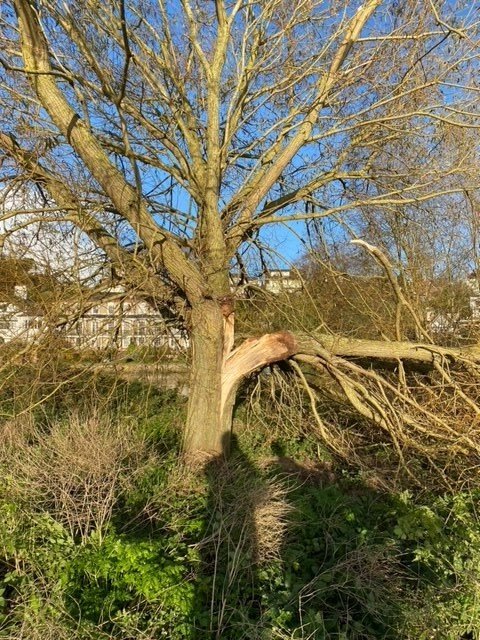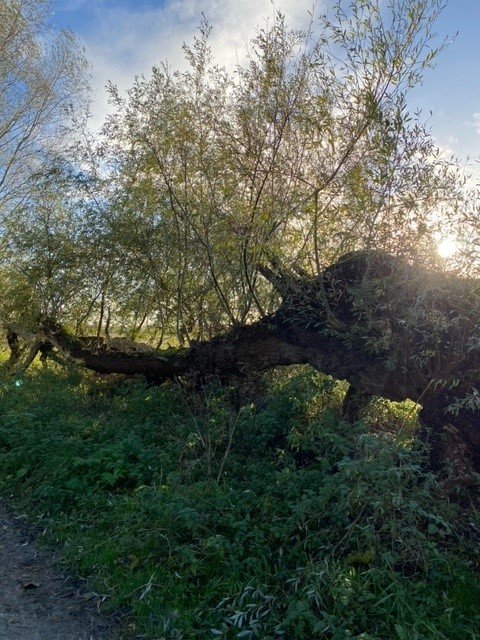A guided walk exploring the ecology of the Chester meadows
In-line with our commitment to connect people with nature, we have put together a guided walk that can be followed along the Chester meadows. The aim of this walk is to show that a connection with nature does not have to be season-dependent and rich flora can be abundant no matter the season. So, don your hat, gloves, and wellies whilst Land Studio’s ecologist Val Gateley takes us on a walk to showcase the diverse plant-life to be found on the meadows.
The guided map. Starting from the Queen’s park suspension bridge this walk should take about an hour.
Beginning the walk, the first thing one might notice is the abundance of what is called ‘Tufted Hair Grass’. This hazel-coloured grass carpets the meadows, giving it a beige hue in the colder months. Try and pick a strand of grass and run it between your fingers in both directions. The interesting silica structure of the grass makes it unappetising to grazing fauna, a side effect of this means that it’s got significantly more friction when rubbed in one direction.
Tufted Hair grass
Deschampsia cespitosa
Walking on, you may notice the yellow flowers that dot the hedgerows along the borders of the fields. This is gorse, its yellow flowers add a welcomed splash of vibrancy amongst the otherwise drab colour palette of the British winter. It’s said one should only kiss a girl if the Gorse is in bloom, but of course, Gorse is always in bloom. If it were warmer you may notice a sweeter aroma from the flowers, some go so far as to describe it as smelling like a Piña colada.
Gorse
Ulex europaeus
As the path turns you will notice this tree shown below (left), this is Crack willow (Salix fragilis). You would be justified in thinking this tree has succumb to the adverse British weather and lost an appendage. However, Crack Willow can bounce back from such injuries. On the right is a Crack Willow that has had time to grow shoots from its fallen trunk.
Moving on, we see this almost alien looking plant, with urchin like heads on the end of its stalks. This is a Lesser Burdock, though not the kind of Burdock that is used for Dandelion and Burdock, it is related. Look closer at the heads and you will see its small hooked structures that it used for seed dispersal. The Burdock plant was indeed what inspired the inventor of Velcro to develop their hook-and-loop fasteners.
Lesser Burdock
Arctium minus
Crossing over the field you may notice these purple flowers dotted amongst the vegetation. This is hedge woundwort, a pretty sight in the colder months, you may mistake its leaves for that of a stinging nettle. Fret not, this plant will not sting you- but rubbing the leaves between your fingers may harm you in a different way… As the name suggests, Woundwort has a rather unpleasant smell, often described as ‘fetid’. Whilst we may appreciate the natural environment mostly through sight and sound, its important to engage the other senses and note all that our environment has to offer.
Hedge Woundwort
Stachys sylvatica
Our final identified plant species was that of the Water Chickweed. A floodplain meadow species, it’s presence on the meadows does not go amiss. But, don’t let this take away from the significance of seeing it. Notice its delicate stigma and the fragility of its white petals. Water Chickweed is dotted all along the River Dee, though increasingly it is becoming rarer along our British riverbanks. So, be sure to put extra effort into spotting its dainty flower.
Water Chickweed
Stellaria aquatica
Setting out on this walk with the aim to find all the identified flora in this guide is a good start. But, don’t let this restrict you, there were numerous interesting and notable species to be found in this environment. It’s important to be mindful of this diversity when we experience our landscapes as it can be quite easy to overlook. If everyone were to realise the ecology of the everyday, then we could put more emphasis on its enrichment, enhancement, and protection.








